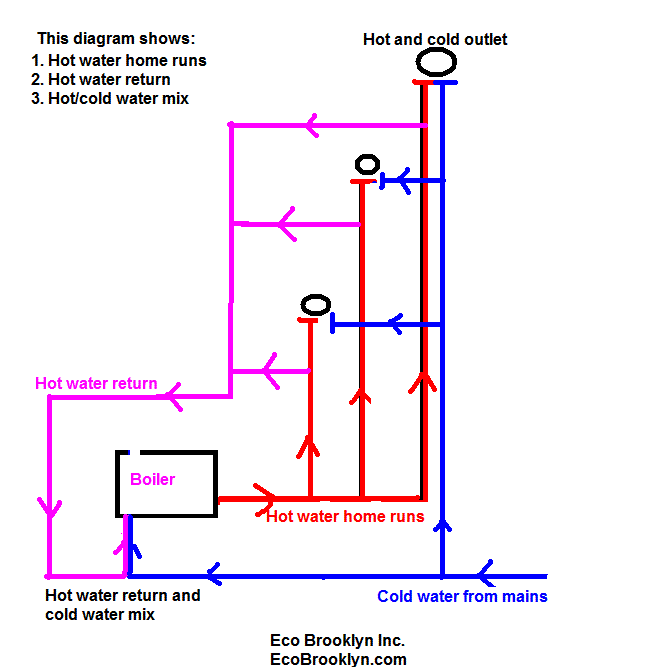Here is an image of the proposed plumbing setup for the green show house in Brooklyn. Chester Birchwood from New York Solar Systems is installing it.

It has three interesting components. These apply to hot water only since we are really managing the amount of energy we added to the hot water. The cold water doesn’t apply to the same needs as you may see below.
1. Hot water home runs
This is when all hot water pipes in the house, usually 1/2″ thick, go directly from the boiler to the outlet with an individual line each. Or instead of each outlet you could do home runs to each floor in the house, where there is an individual line going from the boiler to each seperate floor. This is instead of the normal way of having a main hot water pipe, usually 3/4 inch, that is called a riser and has 1/2″ branches off of it going to each outlet.
The problem with the main riser option is that when you turn on the faucet it takes a long time for all the cold water in the larger 3/4″ inch pipe to flow down the drain until eventually the hot water arrives. The home run means there is a smaller 1/2″ pipe going directly to that one faucet. This means less water has to run down the drain until the hot water arrives. The difference between 3/4″ and 1/2″ is actually a lot of water so with the home run you wait less time for the hot and you also waste less water waiting.
2. Hot water return
A hot water return setup is when there is a pipe that is connected to the hot water pipe near the outlet and it returns back to the boiler. In this configuration you have a pump on the line that is constantly circulating the hot water in a loop. This means there is instant hot water when you turn on the tap.
Normal builders use this set up for user convenience because it is luxurious to have instant hot water. But there is a green aspect since you aren’t wasting water down the drain waiting for the hot water to come. Green builders are using the hot water return to save water more than the convenience of having hot water 30 seconds sooner.
But there is energy wasted as the heat escapes out of the constantly hot pipe (even if it is insulated). The boiler has to keep reheating the water. And the pump also consumes electricity. Normal builders don’t care since this is normally done for high end buildings where money (or ecology) is not the main concern.
For green builders this wasted energy is an issue. It defeats the purpose of saving water. A few solutions are normally used to solve this. The first is to have a switch near the faucet that turns on the pump for 30 seconds. Instead of turning the faucet on and waiting 30 seconds you flick the switch, wait 30 second, THEN turn on the faucet for your “instant” hot water.
A variation on this is to have an automatic sensor near the faucet (usually motion sensor) that turns the pump on when you move in front of it. Thus you avoid having to remember to flick the switch. This later option is not great since studies have shown there are too many false alarms, i.e. somebody simply walking by the sensor.
Another option is to avoid the sensor or switch and put the pump on a timer, for example so that it turns on every morning for an hour and then again in the evening for an hour. This means during peak usage there will be hot water on demand (and thus no wasted water waiting for it). And when people rarely use the hot water (middle of the night for example) the pump is also sleeping and no energy is wasted.
A variation on that, and some say a better one, is to put a temperature sensor on the pump and use a variable speed pump. This means it will pump water until a certain temperature is reached and then it will slow down the water pumping to a slow trickle. One plumber who does this says that the electricity used to power the pump at that speed is almost nothing. “So little electricity you could put your tongue on it”, he says. And if the pipes are insulated you don’t need to worry too much about heat loss there. Perhaps, but I do.
This brings me to the system we are devising in our show house. We will have a combination of two methods: we will have a timer that turns the pump on only at peak periods. AND we will have a variable speed pump that slows to a trickle when the water reaches a certain temperature. And of course the pipes will be fanatically insulated.
3. Hot and cold water mixing
This one I don’t fully understand and thus am not fully sold on it yet. But Chester claims it is a good idea and he has done a good share of boiler installations. The set up is where the hot water return is mixed with the cold water from the mains right before entering the boiler. The idea is that the water entering the boiler is warmer than normal and thus the boiler uses less energy to heat it up. My confusion here is that I don’t see why you would want to cool the water that is circulating in the pipes of the hot water return. I still have to get my head around this one.
